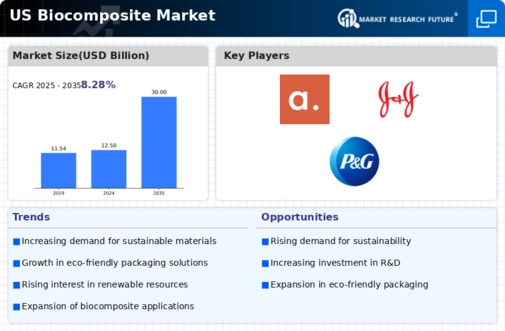The biocomposite market exhibits a dynamic competitive landscape characterized by a growing emphasis on sustainability and innovation. Key players such as BASF SE (Germany), NatureWorks LLC (US), and Trex Company Inc (US) are at the forefront, each adopting distinct strategies to enhance their market positioning. BASF SE (Germany) focuses on innovation through the development of advanced biopolymers, while NatureWorks LLC (US) emphasizes partnerships to expand its product offerings in the biocomposite sector. Trex Company Inc (US) leverages its established brand in composite decking to penetrate new markets, indicating a trend towards diversification and strategic collaboration among these companies.
The business tactics employed by these firms include localizing manufacturing and optimizing supply chains to enhance efficiency and reduce costs. The market structure appears moderately fragmented, with several players vying for market share. However, the collective influence of major companies like BASF SE (Germany) and NatureWorks LLC (US) suggests a potential for consolidation as firms seek to strengthen their competitive edge through strategic alliances and mergers.
In October 2025, NatureWorks LLC (US) announced a partnership with a leading agricultural firm to develop a new line of biocomposite materials derived from sustainable feedstocks. This strategic move is likely to enhance NatureWorks' product portfolio and align with the increasing demand for environmentally friendly materials. The collaboration underscores the importance of integrating sustainable practices into product development, which could position NatureWorks as a leader in the biocomposite market.
In September 2025, Trex Company Inc (US) unveiled a new manufacturing facility aimed at increasing production capacity for its biocomposite decking products. This expansion is significant as it not only meets the rising consumer demand for sustainable building materials but also enhances Trex's operational efficiency. The facility is expected to reduce lead times and improve supply chain reliability, which are critical factors in maintaining competitive advantage in the market.
In August 2025, BASF SE (Germany) launched a new biopolymer that is designed to be fully biodegradable, targeting the packaging industry. This innovation reflects BASF's commitment to sustainability and positions the company to capitalize on the growing trend towards eco-friendly packaging solutions. The introduction of such products may shift consumer preferences and compel competitors to enhance their own sustainability initiatives.
As of November 2025, the competitive trends in the biocomposite market are increasingly defined by digitalization, sustainability, and the integration of advanced technologies such as AI. Strategic alliances are becoming more prevalent, as companies recognize the need to collaborate in order to innovate and meet evolving consumer demands. The competitive landscape is likely to evolve from a focus on price-based competition to one centered on innovation, technology, and supply chain reliability, suggesting that companies that prioritize these areas will be better positioned for future success.














Leave a Comment